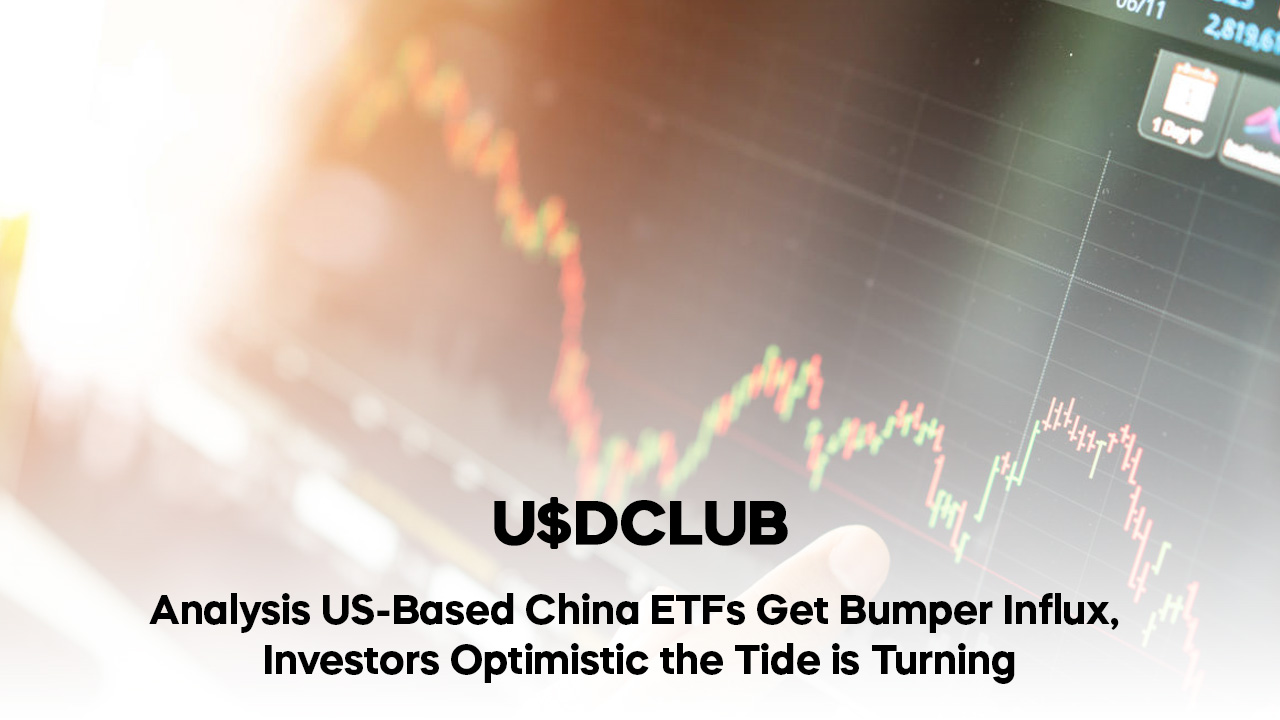As 2024 progresses, *China’s economy* and financial markets have been marked by a rollercoaster of events that have left global investors wary. Slowing economic growth, trade tensions with the United States, regulatory crackdowns, and challenges within China’s key real estate sector have caused a significant drag on the country’s stock markets in recent years. However, recent inflows into *US-based China Exchange-Traded Funds (ETFs)* suggest that some investors believe the tide is finally turning.
In this blog, we will explore the reasons behind the surge of investments in US-based China ETFs, examine the macroeconomic factors that are leading to renewed investor interest, and analyze the potential risks and rewards of these investments.
What are US-Based China ETFs?
Before diving into the details of the recent influx, it’s important to understand what *China-focused ETFs* are and why they matter to investors. An ETF is a type of investment fund that is traded on stock exchanges, much like individual stocks. ETFs pool capital from multiple investors to invest in a basket of securities—often mirroring the performance of an index. China ETFs are specialized ETFs that give investors exposure to the Chinese economy by holding stocks of Chinese companies or companies with substantial ties to China.
Some of the most prominent China-focused ETFs in the US include:
– *iShares MSCI China ETF (MCHI)*
– *KraneShares CSI China Internet ETF (KWEB)*
– *SPDR S&P China ETF (GXC)*
– *Xtrackers Harvest CSI 300 China A-Shares ETF (ASHR)*
These funds cover a broad range of sectors from technology to consumer goods, real estate, and financials, allowing investors to diversify their exposure to China without having to invest in individual companies directly.
Recent Surge in Inflows: What’s Behind the Optimism?
In recent months, US-based China ETFs have experienced a *significant uptick in inflows. According to data from **Morningstar, over *$1.5 billion** has flowed into China ETFs in the past quarter alone, with the most popular funds such as *KWEB* and *MCHI* receiving substantial attention. This comes as somewhat of a surprise given the *turmoil* that has plagued China’s economy in the last few years, including a slowdown in GDP growth, the bursting of its real estate bubble, and mounting geopolitical tensions.
So, what is driving this renewed optimism?
-
*China’s Economic Stabilization Efforts*
In response to its slowing economy, the Chinese government has undertaken a series of *stimulus measures* aimed at stabilizing the country’s growth. These include reducing interest rates, injecting liquidity into the banking system, and easing restrictions on the *property market* to revive its struggling real estate sector.
In particular, recent moves to *cut mortgage rates* and *reduce property taxes* have been interpreted as signals that Beijing is ready to support economic growth through more aggressive fiscal and monetary policy. This has led to renewed investor optimism that the worst of China’s economic downturn may be behind it.
Moreover, China’s shift from a *zero-COVID policy* to reopening its economy has led to hopes that *consumer demand* will rebound, boosting sectors such as retail, travel, and technology. This has been a key factor driving the rally in China ETFs.
-
*Cheap Valuations*
Another major factor contributing to the influx into China ETFs is the *attractive valuations* of Chinese stocks. After several years of underperformance, many Chinese companies—especially in the *technology* and *real estate* sectors—are trading at steep discounts relative to their global peers.
For instance, *Alibaba (BABA)* and *Tencent (TCEHY), two of the largest technology companies in China, have seen their share prices fall significantly from their peaks. This has led some investors to see these companies as **bargain buys*, especially as the fundamentals of their businesses remain strong despite regulatory crackdowns.
-
*Geopolitical Thawing*
While geopolitical tensions between the US and China have been a persistent source of concern for investors, there are signs that relations could improve. The Biden administration has taken a *more measured approach* to trade negotiations, and some analysts believe that both countries may seek to stabilize their economic ties amid broader global uncertainties.
Additionally, China’s decision to *reopen dialogues with the US* on issues such as *climate change, **trade, and **tech cooperation* has signaled a potential easing of tensions. If these negotiations prove fruitful, it could lead to improved market sentiment and more favorable conditions for Chinese companies listed in the US, such as *JD.com* and *Baidu*.
-
*Long-Term Growth Prospects*
Despite the short-term headwinds, China’s long-term growth prospects remain robust. China continues to be the world’s second-largest economy and is projected to grow at a relatively steady pace for the foreseeable future, driven by its growing middle class, technological innovation, and global leadership in industries like *renewable energy, **electric vehicles, and **artificial intelligence*.
Moreover, China’s *Belt and Road Initiative* and its ambitions to become a global economic superpower further solidify the long-term growth potential of the country. Investors are betting that as the country stabilizes and repositions itself in the global economy, companies within China will see significant upside.
Key US-Based China ETFs Seeing Major Inflows
-
*KraneShares CSI China Internet ETF (KWEB)*
KWEB has been one of the biggest beneficiaries of the recent influx, with *over $500 million* flowing into the fund in the last quarter alone. This ETF tracks *Chinese technology and internet companies*, such as Alibaba, Tencent, JD.com, and Baidu, which have suffered steep declines due to regulatory crackdowns but are now trading at attractive valuations.
The renewed interest in KWEB can be attributed to the Chinese government’s easing regulatory environment, particularly in the *tech sector*, and improving macroeconomic conditions. Additionally, tech companies are expected to benefit from the recovery in consumer spending post-pandemic.
-
*iShares MSCI China ETF (MCHI)*
MCHI is one of the most popular China ETFs, providing broad exposure to large and mid-cap Chinese stocks. The fund includes holdings across a variety of sectors, from *technology* and *consumer goods* to *financials* and *healthcare*.
MCHI has also seen a significant uptick in inflows, with investors betting that the fund’s *diversified exposure* will allow it to benefit from China’s overall economic recovery. As one of the largest China ETFs, it’s often viewed as a *core holding* for investors seeking exposure to the country.
-
*Xtrackers Harvest CSI 300 China A-Shares ETF (ASHR)*
ASHR focuses on *China A-shares*, which are stocks of mainland Chinese companies that trade on the Shanghai and Shenzhen stock exchanges. These A-shares have been historically difficult for foreign investors to access, but ASHR provides a simple and liquid vehicle for investors to gain exposure to this market.
ASHR has been a top performer as of late, with over *$200 million* in inflows. The fund is popular among investors seeking exposure to domestic Chinese companies that may benefit the most from the country’s economic reopening and stimulus measures.
Potential Risks to Consider
While the recent influx of capital into US-based China ETFs is a positive sign, it’s important to note that there are still significant risks to investing in these funds.
-
*Regulatory Risks*
One of the most significant risks facing Chinese companies remains *government regulation. The Chinese Communist Party has shown a willingness to crack down on sectors it views as problematic, particularly the **tech* and *real estate* industries. While recent signs suggest the government is easing its regulatory grip, this could change quickly if the authorities decide to pursue new reforms or policies.
-
*Geopolitical Tensions*
Despite some signs of thawing relations between the US and China, the *geopolitical landscape* remains uncertain. Tariffs, trade restrictions, and concerns over the *delisting* of Chinese companies from US exchanges continue to weigh on market sentiment. Any deterioration in US-China relations could lead to renewed market volatility.
-
*Economic Headwinds*
China’s economy is still facing several challenges, including a slowdown in growth, a fragile real estate sector, and *demographic shifts* that may impact future economic expansion. Investors should remain cautious about the potential for *continued economic weakness*, especially in the near term.
-
*Currency Risk*
Investing in Chinese ETFs also exposes investors to *currency risk, as fluctuations in the value of the **Chinese yuan* relative to the US dollar can impact returns. A weakening yuan could reduce the value of investments in US-based China ETFs.
Conclusion: Is Now the Time to Invest in China ETFs?
The recent influx of capital into US-based China ETFs reflects growing optimism that the worst may be over for China’s economy and its stock markets. Factors such as *government stimulus measures, **cheap valuations, and **improved geopolitical relations* are driving renewed investor interest in Chinese stocks.
For investors with a high-risk tolerance and a long-term investment horizon, now may be a good time to consider adding China ETFs to their portfolio, particularly given the *attractive valuations* and potential for growth in sectors such as *technology, **consumer goods, and **infrastructure*.
However, it’s crucial to remain mindful of the risks, including regulatory uncertainty, geopolitical tensions, and economic headwinds. As always, diversifying your portfolio and maintaining a balanced approach is key to navigating the complexities of global markets.
For more updates on the latest developments in the cryptocurrency market and insightful investment strategies, stay tuned to *USDCLUB.us*, where we provide timely news and analysis from the world of finance.







